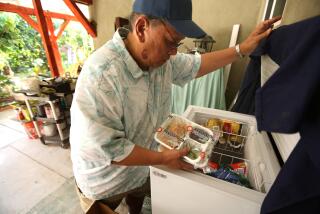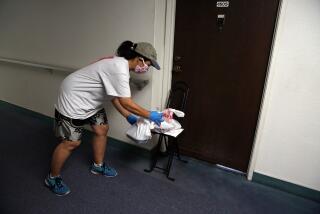Not all welcome skid row charity
Los Angeles police officer Deon Joseph followed a trail of discarded paper plates and half-eaten macaroni down 6th Street and around the corner into San Pedro Street.
There he found his targets: members of a church group, heads bowed in prayer after serving lunch to a long line of homeless people.
Dozens of groups from across the Southland converge on downtown Los Angeles every week to hand out food and clothing in skid row, which has been called the homeless capital of the nation.
Most draw a crowd, but not everyone is happy to see them. Residents and business owners complain about the trash they leave behind. City officials question the wisdom and safety of street distributions in an area with numerous organizations that help the homeless.
“These folks don’t know what happens when they leave,” said Joseph, who as senior lead officer is a liaison to the community. “We’ve had people get stabbed after fighting over clothes. We’ve had people get sick after eating their food. It’s just dangerous and irresponsible.”
Some community activists allege that the opposition to street distributions has more to do with gentrification than with protecting homeless people. The city’s vision for a revitalized downtown, they suggest, does not include soup lines.
Los Angeles City Councilwoman Jan Perry, who represents the area, dismisses the accusation, saying thousands of low-income housing units have been built alongside luxury loft developments.
“Nobody has been moved out of the area,” she said. “Feeding people on the street is not hygienic, it’s not sanitary, it’s not good for their health.”
She has asked the Los Angeles County Department of Public Health for stricter enforcement of food safety regulations. This summer, environmental health inspectors stopped at least two groups from distributing food in skid row because they did not have permits.
Members of the Los Angeles Community Action Network are planning a skid row picnic for Sept. 30 to protest the actions. They say it is unfair to expect those who are giving away food to meet the same standards as commercial vendors, which include serving from a location with facilities to wash both hands and utensils.
“It would be literally impossible to meet all their requirements,” said activist Michael Hubman, who argues that people have a right to share food.
James Parham of World Agape, which runs a resource center for the homeless, said his church group had been serving dinner in the same spot on Towne Avenue for five years. The first time anyone asked to see a permit, he said, was when inspectors shut down the food service June 2.
“The community is changing,” Parham said. “Different people are moving into the area. That’s what I think caused it to escalate to this.”
Terrance Powell, who heads the county Environmental Health division’s Bureau of Specialized Surveillance and Enforcement, said the goal was to ensure that any food provided was “healthy and wholesome.”
“I think this is particularly important when one deals with the homeless, because they don’t have the safety net or the benefit of medical access as other citizens do,” he said.
Discarded food also attracts rats, cockroaches and pigeons, said Estela Lopez, executive director of the Central City East Assn., which represents property owners and local businesses, including plants that process and store frozen seafood.
“People line up for things when they see there is a free give-away, whether they need them or not,” she said. “Then they discard it.”
Some groups clean up after themselves, but she said others leave bags of bread or clothing on the curb.
“It just wouldn’t happen in any other business area,” she said.
Lopez said city sanitation trucks do not service businesses and apartment blocks, so her association spends about $470,000 a year picking up litter off the streets, emptying trash cans and paying a private contractor to haul the waste to a dump. In the section of skid row that is not covered by her association, some residents have banded together to form their own volunteer street cleaning service called Operation Facelift.
“People don’t respect skid row as a community,” said the group’s founder, Manuel Benito Compito, who stood in soup lines for his meals in the past. On occasion, he admits, he probably dropped his plate in the gutter because there was no trash can available. His group now puts them out. “Especially on the weekends, the majority of the garbage on the streets was coming from the people giving food.”
Many people distribute aid within steps of shelters run by the Union Rescue Mission, Los Angeles Mission and Midnight Mission, which together serve about 7,000 meals a day. When Joseph, the police officer, spots them, he asks them to consider donating their time and resources to one of these organizations, which also have programs to treat the drug addiction and mental health issues that keep many people on the streets.
“When you continue to feed the homeless in the street, they stay in the street,” he said.
The three missions and other neighborhood organizations that help the homeless have offered to make their kitchens and dining facilities available to outside groups that would like to serve meals.
“We’re all ultimately trying to achieve the same cause, and that’s to end homelessness,” said Herb Smith, president of Los Angeles Mission.
But some people who live on the streets say they don’t like dealing with institutions. Diamond Mendoza said he gets rude comments because he is gay and is rushed along when he eats at some missions.
He used to be a regular at the World Agape food truck.
“We were devastated” when they stopped serving, he said. “It was like a social gathering that was just taken away.”
Matthew Hendry, who coordinates the food outreach program for the Dream Center, which was issued a violation notice July 15, said serving meals is a way to get to know people and tell them about the center’s rehabilitation programs.
“It’s not just about food. It’s about making a positive change in their lives,” he said.
The Dream Center has stopped distributing food on 6th Street since receiving the warning. But the group continues to serve lunch twice a week in the courtyard of a drop-in center operated by Volunteers of America.
Mendoza was among at least 200 people who lined up for the center’s Kung Pao chicken and sloppy joes one recent afternoon. He pronounced the food excellent.
“It’s people who live in lofts and houses who look down and complain,” he said.
A short walk away, Joseph, who has worked in the area for the LAPD for 13 years, spotted a commotion.
On the 6th Street, Tom and Nancy Briggs, who make a monthly trip to skid row from Riverside with family members, had set out several plastic bins full of clothes collected from friends and colleagues. The family was instantly surrounded by people, some of whom grabbed armfuls of clothes and stuffed them into bags.
“Have you seen one naked person today in skid row?” Joseph asked, before crossing the street to speak with them. “All that’s going to happen is they are going to walk around the corner and start bartering for crack.”
Tom Briggs said he knew some items would be sold but added others would be used by people who had worn out their clothing.
Joe Nunley, an 85-year-old blind man who goes by the name Pops, was delighted to receive some clean underclothes, a shirt and two pairs of socks.
“I don’t get too many clothes because I don’t have nobody to take me” to the missions, he said. “I don’t like to ask people to help me because they are kind of mean to me.”
More to Read
Sign up for Essential California
The most important California stories and recommendations in your inbox every morning.
You may occasionally receive promotional content from the Los Angeles Times.










